Project Flying Carpet Llorenç del Penédes, Catalunya, Spain, April 2011
The 'Flying Carpet Project' is the result of a collaboration between Liliya Lifanova, the 5th grade students of the School Les Cometes de Llorenç del Penedes, and a group of local stitchers. Inspired by the myths and the nomadic traditions of her native Kyrgyzstan, the artist held a workshop where the children were involved in the creation of a felt carpet. The workshop however was not merely a didactic activity but an experience where the children disclosed to the artist the location of their magical, real and imaginary places at Cal Figueres and its environments, the farmhouse where the workshop was held. Through careful production (costumes, props and staging), Liliya Lifanova created a dream like, magic scenario, where the children were urged to access their inner wizards so as to imbue their work with flying capabilities. The felt pieces made by the children were then sewn together, by a group of women from the village to create the flying carpet. In the espai d’Art Les Quintana the precious object was presented alongside a selection of edited material filmed during the workshop as well as the drawings that the children made in response to the question: Where would you go if you had a Flying Carpet? Along with 'The Flying Carpet Project' at espai d’Art Les Quintana, Lifanova presented ‘Untitled (Newspapers from January-March 2011 Robert family Llorenç del Penedés)’ a work based on meditative repetition. It was comprised of over 5000 pieces made of fragmented and rolled newspaper that the family Robert accumulated in their home between January and March 2011. The result is a spectacular landscape-archive in a shape of a river where the patient, dedicated and healing action of the artist is reflected. | 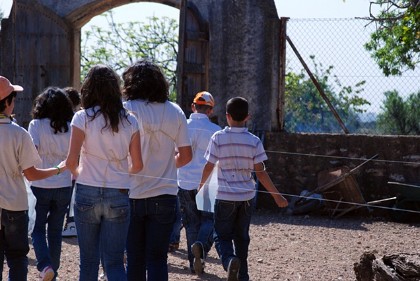 Photo from Project Flying Carpet Llorenç del Penédes, Catalunya, Spain, April 2011 |
Yun: Who and what inspired “Anatomy is Destiny”? Does your work have any specific genealogy for being located in the art world? Could you also explain your educational background in textile and performance art?
Liliya: When I began working on Anatomy is Destiny, on some level, I think I was still thinking a lot about chess as an art stage. Specifically, I think this project was an attempt to confront and exorcise my “Art Gods”. If you look at my graphs of the chess match, each piece was symbolized with an image that was significant to me, that represented a figure in art that I was obsessed with. It was fun to imagine how each of these people would navigate the board… For instance, in such a version of the game, I imagined that Bruce Nauman would be a Knight.
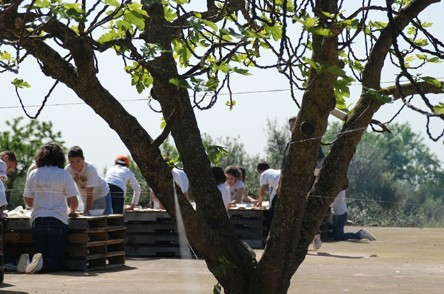 Photo from Project Flying Carpet Llorenç del Penédes, Catalunya, Spain, April 2011 Yun: Not only did you direct and set up the project, you also custom designed "Anatomy is Destiny." You could have let other people be involved in the process, however, you did not. You also made custom aprons for the children in "Project Flying Carpet." I tend to think that sometimes artists working with video or other non-analogue media prefer to work by hand and that part of generating the project by hand links it to the shamanistic value of labor and the alchemistic value of materials. What do you think? Is there a reason why you labor throughout the entire process of your work? Liliya: I am a stickler for authenticity. Even if it will end up looking like it’s made in a factory, I prefer to make it myself. Sometimes the labor is absolutely unnecessary, why waste all this time making something that is already out there? But it buys me time to think through the different parts of the project and via this process I am also able to suggest to the participants the nature of their roles. I think of it as yet another directing tool. Yun: When I was at CeRCCa with you, you had a very disciplined practice of working every day. This was impressive since I believe that it was about you adapting to the situation through your material. By adapting to the situation, the function of a fabricator might have different meaning even though you are repeating the same gesture again and again. Could you explain how you made Untitled (a Jewish prayer for journeys)(2011), and what you felt and thought while you were making it? | So in my drawings the Knight holds a position that reminds me of Nauman’s Beckett Walk. The qualities of Richard Serra’s work made me think that he would be a Rook on such a stage, and the spiritual qualities in Damien Hirst’s work, slicing the board on a diagonal, were that of a Bishop, etc. This probably sounds confusing and my work has nothing to do with the work of any of these people, but as I was making this piece I was in my first year of graduate school, studying in the department of Fiber and Material studies, studying the nature of art through the materials it employs… So here was this match, and here were my materials - canvas backed with linen, two grounds that I was resisting, and they had a face off…
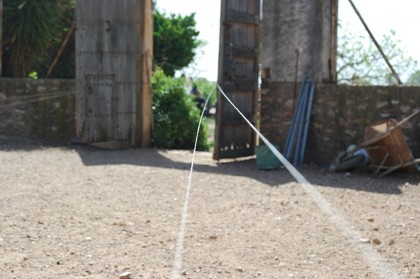 Photo from Project Flying Carpet Llorenç del Penédes, Catalunya, Spain, April 2011 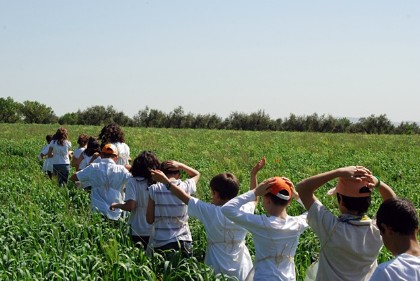 |
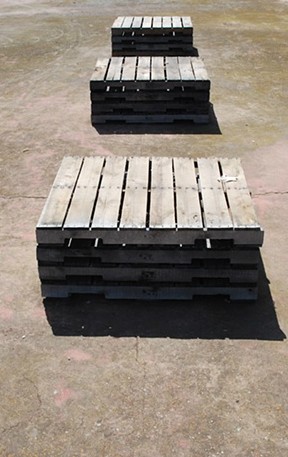 Photo from Project Flying Carpet Llorenç del Penédes, Catalunya, Spain, April 2011 | Photo from Project Flying Carpet Llorenç del Penédes, Catalunya, Spain, April 2011 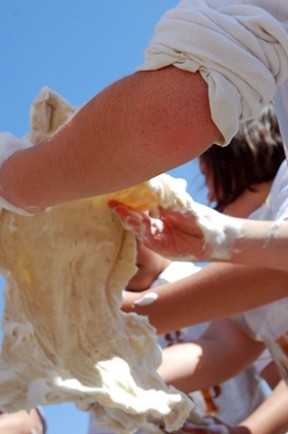 Photo from Project Flying Carpet Llorenç del Penédes, Catalunya, Spain, April 2011 |
Liliya: The Rolled Series for me has been one continuous, linear language for some time now. I do it wherever I am and no matter what project I am working on. I think this practice is about the wait…. Most of the time the process is hollow; I feel some discomforts in my body, but I have no specific emotions or organized thoughts. But that seems to be the key practice. The process of shredding materials and then rolling them, repeating this predictable pattern endlessly, creates a kind of a ‘safe place’ where I can allow ideas to arrive, marinade, or crystallize. So it’s more like using the rosary and less like I am making objects. Making Untitled (a Jewish prayer for journeys) was an appropriate product of this practice. I was making this piece at the same time as I was working on the Flying Carpet Project part II in Belalcázar, at a residency that is housed in a convent. Yun: Let’s talk about “Project Flying Carpet.” You started the project in Llorenç del Penedés, Catalunya, and then moved to Belalcázar, Andalucia with the “magic carpet.” I was with you in Llorenç del Penedés when you planned the workshop for the children, and as a person who remembers some details of it, the entire process was very magical. In the workshop, children seemed to know what they needed to do, even though the adults who were planning things were not sure about whether the children could actively participate and build the narrative by themselves. At some point, they were leading our minds toward their world and talked about how they could help by giving magic to the carpet. | 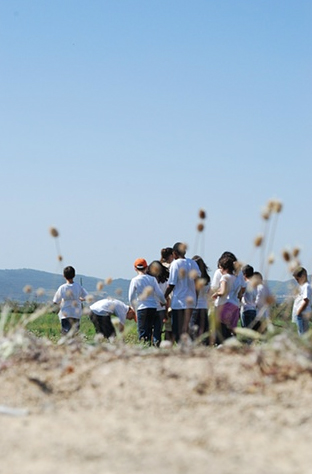 Photo from Project Flying Carpet Llorenç del Penédes, Catalunya, Spain, April 2011 |
I remember so many beautiful moments during the project in Llorenç del Penedés. The project was not only about art making, but also a netting of children, locality, history, and the community. You actually fabricated the link between artists who came from outside the community and the people and culture that is there. Liliya: Yes, for me too it was magical. For me, this project was about trust and discovery. In that situation, as a visitor, I could control only some areas of the experience. It was beautiful not to be in a position of a prophetic artist, to give up this idea that I have to show them something but rather let them guide me to the things they thought are special. It was very touching to be on the receiving end. Yun: I believe that the generation in Llorenç del Penedés
will remember the visitor who asked them to create a magic carpet and it might
be a generational memory in that town. What do you think?
Sometimes artists make the mistake of jumping into local people’s life by the virtue of their status as artists and therefore somehow enlightened. As I believe an artist should be a parasite of a society, that kind of attitude can produce another hierarchy problem. However I think your project was very poetic in terms of how you participated in the local life as a subject who has her own story but needed some help from them. Your project linked different generations. When the local women helped with sewing the carpet together, you were not the person who asked them to do it. Children in the town sent letters to the older women, and that motivated them to participate. If a foreign artist asked for their help, it might have been different. What did you feel about your position in that dynamic? | 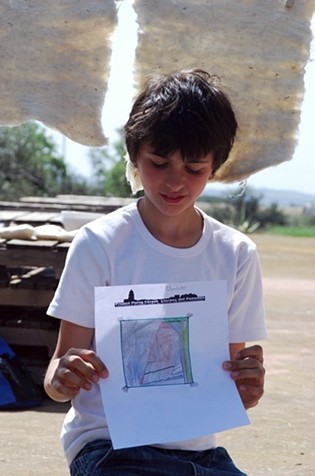 Photo from Project Flying Carpet Llorenç del Penédes, Catalunya, Spain, April 2011 |
Liliya: I wanted to enter a state of possibility. Only to imagine that something that is sometimes known to be impossible (disconnect among generations, discord between regions, cynicism) is in fact a non-issue when approached through creativity.
Flying Carpet Prayers, La Fragua Artist Residency, Belalcázar, June 2011
Introduction:
In El Pósito, temporary stored, were pieces that contain memories of my experience in Belalcázar. I came to this village, carrying a precious object on my back: the Flying Carpet that was made for me by the children of Llorenç del Penedés, Catalunya. I presented it to the 5th graders of colegio Sor Felipa de la Cruz as an offering, with a plea for another carpet to be made for me as well as the Catalan children. Together, we felted wool in the ancient laundry room, a site no longer useful, like the process of making felt from scratch, abandoned practices in our society. As wool slowly transformed into felt, each fiber irreversibly interconnecting with the next, we created a dense substrate that is a metaphor of our society. From this site we entered the intangible space, the space of memories and transformation. Imitating a flock of sheep, bell in their hands, the children steered me through the extraordinary sites of their town’s garment: the church, the cave, the roman bridge, the overview, and of course the castle. We only scratched the surface, but I felt the magic and saw the village through their eyes. In El Pósito, I presented what was given to me: the experience of working at the convent, and the physical memories of my collaboration with the village. Displayed there was the generosity, the patience with my lack of Spanish, video of the magical children working, and the visible and invisible work of many men and women, coming together in unison to create something that is known to be impossible. I view Project Flying Carpet as an attempt to return to seeing, to the collective, to a way of working and living at a slower pace, the pace of a land insect, the sheep, slowly traveling up and down dusty Cañada Reals - thorough, productive and moving forward. The Flying Carpet Prayers exhibition is a calcification of a fantasy about a version of a world in which we effortlessly make decisions as a group, welcome strangers with open arms, notice how special and generous the world in which we live is, stitched together by faith in the boundless potential of creativity. Liliya Lifanova 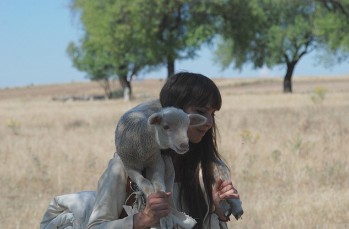 | 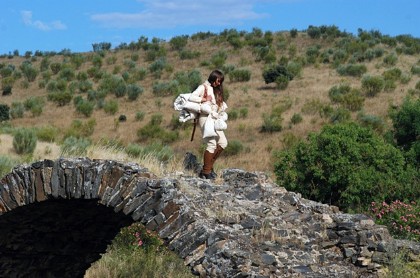 Project Flying Carpet Belalcázar, still image from the video project
photography: Rosana Camára 2011 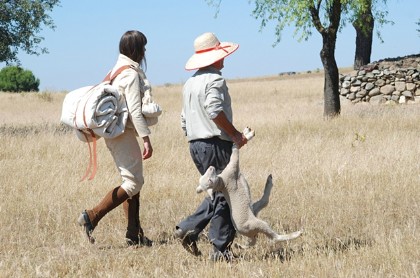 Project Flying Carpet Belalcázar, still image from the video project
photography: Rosana Camára 2011 |
Yun: How was it in Belalcázar? I don’t know what happened there. Could you explain some interesting things that happened during the process of working on Project Flying Carpet there and what you felt?
Liliya: In Belalcázar the workshop was held in an ancient laundry room that was no longer in use. So the structure of the site was very different, it enclosed, but the structure of the workshop remained the same. I asked that we alternate between felting wool and taking mini-journeys to what they thought were the ‘magical’ sites in their town. The most important difference was that the children in Belalcázar were more outspoken, more forward. They were also of the same age (10 y/o) but their ‘texture’ was very different. You might see that in the video, they are more matter of fact, they also seem to spend a lot more time playing outside of their homes so they had a different comfort level in the town and at the sites that they took me to.
I thought that the children in Llorenç del Penedés were presented with a question (where does ‘magic’ live on the premises of Cal Figueres?) and they had to invent the sites on the spot, where as the children in Belálcazar had more or less of an idea of what a visitor would find special about their town. And the stitchers were different. Very lively, funny and decisive. I think that the two groups compliment each other quite well.
Yun: Who were you during the project? I know you were trying to not set up a persona, which could be easily represented by one name, but you were clearly a visitor from outside of their culture, and that gave you a specific persona as a fictional character. And how about their definition about you, in both places, Llorenç del Penedés and Belalázar?
Project Flying Carpet Llorenç del Penédes, Catalunya, Spain, April 2011 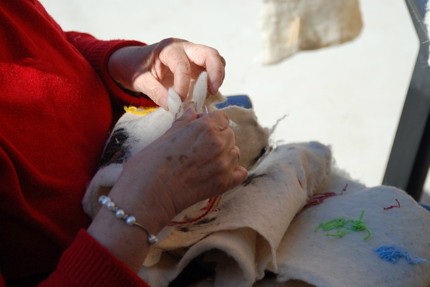 Photo from Project Flying Carpet Llorenç del Penédes, Catalunya, Spain, April 2011 |
|
Project Flying Carpet, Belalcázar, Andalusia, Spain, June 2011 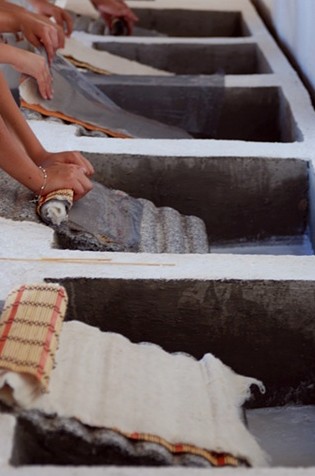 Project Flying Carpet Belalcázar, still image from the video project
photography: Rosana Camára 2011 | Credits: Special Thanks: La Fragua Artist Residency, Jimmy, Manolo and Andre Galindo, Carlos Nero, Gonzalo Duran, Chato and Carlota. Workshop: with the help of Javier Orcaray, Rosana Cámara Participants: Alumnos de 5A and 5B Colegio Sor Felipa de la Cruz Stitchers: Pepa Castillejo Delgado M Josefa Garcia Lopez Antonia Medina Moreno Olalla Torrero Bravo Carmen Medina Moreno Website Photography: Rosana Cámara Video by Esther Marquina |